From Phrase to Phrasing
A Classical Perspective
Chapter 2 – Cadences and Punctuation
The musical phenomenon associated with the repose-moment is the cadence. Nowadays we tend to think of cadences as chord sequences but the concept as it emerges from the treatises is much broader: a cadence is any tone formula that creates the feeling of a complete rest point.8Koch, Musikalisches Lexikon, s.v. Cadenz, see Tonschluss.
A cadence can therefore be just a melodic closing formula and the earliest description in English9according to the Oxford English Dictionary: ‘Cadence, N.’. by Thomas Morley in 1597 is essentially that: ‘A Cadence wee call that, when coming to a close, two notes are bound togither, and the following note descendeth.’10Thomas Morley, Plaine and Easie Introduction on to Practicall Musicke (London, 1597), 73. This is of course from an earlier musical style, nowadays we would probably call this a clausula rather than a cadence, but still the description is of a melodic- rather than an interval-based pattern.

|

|
Figure 6: (left) A cadence as illustrated by Thomas Morley, (right) a clausula.
More than two hundred years later, some of Reicha’s examples of melodic cadences still look remarkably similar:11Reicha, Traité de haute composition musicale, ii, 361.

Figure 7: Melodic cadences by Anton Reicha.
We could argue that cadential harmonies are implied in the melody but that does not diminish the point: a melodic formula, recognized as such, can signal the end (or coming to a rest) of the phrase. Compare for instance some of the trills traditionally added in Baroque music; in unaccompanied solo sonatas they literally signal the end of a phrase. (In older French treatises a trill is habitually called a ‘cadence’.)

Figure 8: Trills signalling cadences: G. P. Telemann, Fantasy for flute solo, TWV 40:9.
Reicha makes the interesting observation that rhythm alone can create cadences. Hearing a drum play the following would not cause any problems in understanding the structure by hearing moments of repose.12Reicha, Traité de haute composition musicale, ii, 363.

Figure 9: Cadences created by rhythm only, example by Anton Reicha.
Structural function and punctuation
Almost all treatises compare music to language when structuring a composition: in language we also need repose-moments to understand a discourse. The most noticeable reposes would be reserved for the main paragraphs/sections, whereas the lesser ones will divide these further into sentences and clauses. Basically we are talking about punctuation.
Likewise in a good composition one would reserve the greater degrees of repose for bigger sections, and the lesser to divide these further. Musical phrases are then separated by colons or semicolons, phrase-parts by commas, and a group of associated phrases (i.e. a musical period) is terminated by a period (dot). (See chapter 6 for problems in comparing language and music.)
It follows that repose-moments need to be variable in strength with weaker cadences acting like commas, and stronger cadences marking important endings.
Hierarchies of strength
The amount of repose can be changed by varying the melodic, rhythmic, and harmonic proportions of the cadence. For each we could set up a sort of hierarchy of cadence-strength, though obviously a ‘feeling’ of repose can never be reduced to a rigid system.
Harmonic aspects
- - The perfect cadence (Fig. 10) is strongest, it creates so much repose that it closes the piece or at least a very big section. For some, like Augustus Kollmann (1756-1829)13Augustus Frederic Christopher Kollmann, An Essay on Musical Harmony according to the Nature of That Science and the Principles of the Greatest Musical Authors (London, 1796), 57. the added seventh is required to be called perfect, others are not so strict.

Figure 10: A perfect cadence by A.F.C.Kollmann.
- - The full cadence is any other V-I that is not strong enough to close the piece, usually for melodic reasons.
- - A half cadence (ending on V) is one degree weaker and always needs to be followed by at least one other phrase.
- - Plagal (IV-I) and mediant (chords a third apart) relations are weaker still. In Classical style they cannot close a phrase, though they can punctuate phrase-members.
- - Deceptive (or interrupted) cadences create minimal repose, or rather deny repose, forcing a phrase to continue.
- - Inversion of chords makes cadences weaker than in root position.
- - Generally a leap in the bass makes the cadence feel stronger than when reached stepwise. Koch even differentiates between a leap downwards (stronger) and a leap upwards (weaker).14Heinrich Christoph Koch, Musikalisches Lexikon (Frankfurt am Main, 1802), s.v. Tonschluss.
Melodic aspects
Melodic cadences are basically melodic formulas that end on the first, second, third, fifth, or seventh note of the scale–relating to an (implied) full- or half cadence.
- - The cadence is strongest if the melody ends in the octave of the chord, (a) and (b) in Fig. 11. Only this so-called octave-cadence can create a perfect cadence. A third (c) or fifth (d) in the melody makes the cadence progressively weaker and unfit for the perfect cadence.
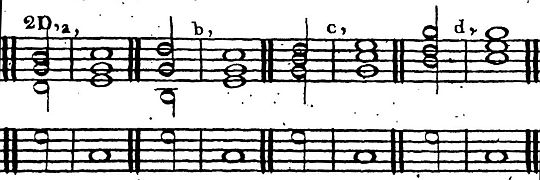
Figure 11: Identical harmonic cadences in decreasing order of strength, example by Kollmann.
- - Some consider the melodic cadence stronger when reached descending (b), others claims the opposite (a). Riepel wisely states that context should decide.15Riepel, Anfangsgründe zur musicalischen Setzkunst - Tactordnung, i, 14. It is interesting to know the word ‘cadence’ is derived from the Italian cadere (to fall, to drop, to decline); also the German word for cadence, Schlussfall (literally ‘enddrop’), relates to this.
- - If the melody jumps into the endnote it is considered less strong than when reached stepwise (i.e. the opposite effect as with the bass).
- - Adding an appoggiatura increases the strength because the added tension leads to more repose in the subsequent release.
Rhythmical aspects
- - The cadence-point usually has a longer note value than the preceding notes as to create a feeling of landing somewhere. Longer values will create more repose.
- - There is often a pause after a cadence, notated or implied, to increase the repose of the cadence before. Without it, or immediately followed by moving notes, the amount of repose is reduced.
- - Ending in a single ‘dead’ note, what Riepel calls unbeweglich (motionless) makes for a stronger cadence than having a subdivision in several notes (beweglich). This clashes with the rule that appoggiaturas strengthen the cadence. For Riepel an appoggiatura is not really part of the melody: written as an ornament it qualifies as unbeweglich and therefore stronger than when written out in normal values.16Riepel, Anfangsgründe zur musicalischen Setzkunst - Tactordnung, i, 19. This feels rather contrived, unless he implied a chord change in the beweglich bar.

Figure 12: Unbeweglich and beweglich, as illustrated by Joseph Riepel.
- - When subdividing on the cadence note, a long-short division is usually considered stronger than short-long.
- - Rhythmical movement in the accompaniment takes away from the strength of the melodic cadence.
- - Context also plays a part. If cadences appear at regular intervals, it becomes predictable where you are supposed to feel repose. (See also phrase-rhythm in chapter 3.)
On the other hand, Beethoven's First Symphony opens with a perfect cadence, but since we are only at the beginning of a substantial piece it is not perceived as an ending. Or the other way around: Haydn’s ‘Joke’ quartet ends with a perfect cadence in bar 166, but the listener, teased by the many G.P.’s that Haydn added, does not perceive it as an ending any more–allowing for the punchline four bars later (see Fig. 13).
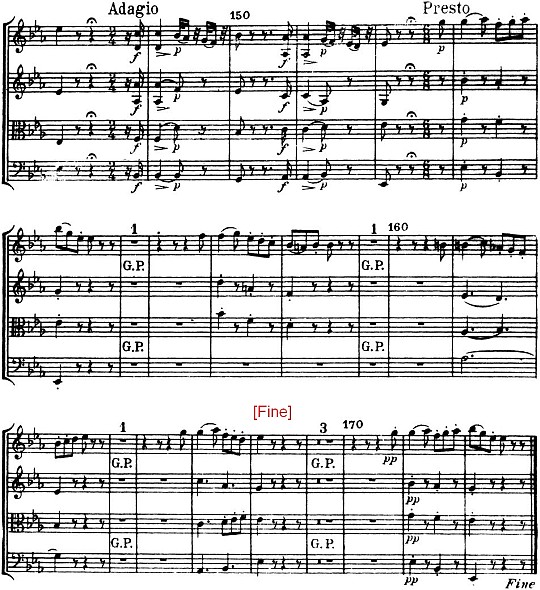
Figure 13: Joseph Haydn's 'Joke' quartet, op.33,2, final bars of the last movement. Edition Eulenburg, [Fine] added by me.
Case study 1: Mozart, Minuet K.315a,2
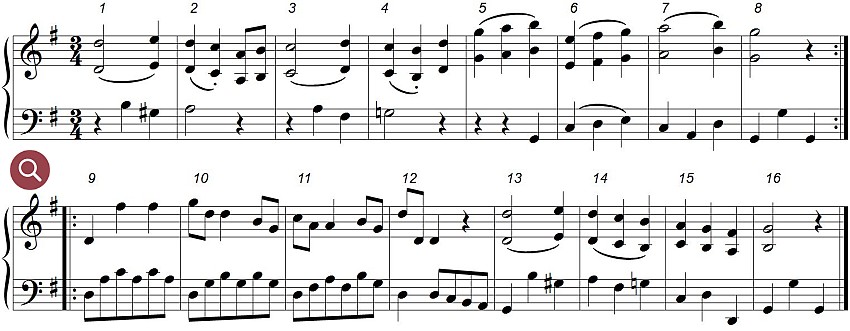
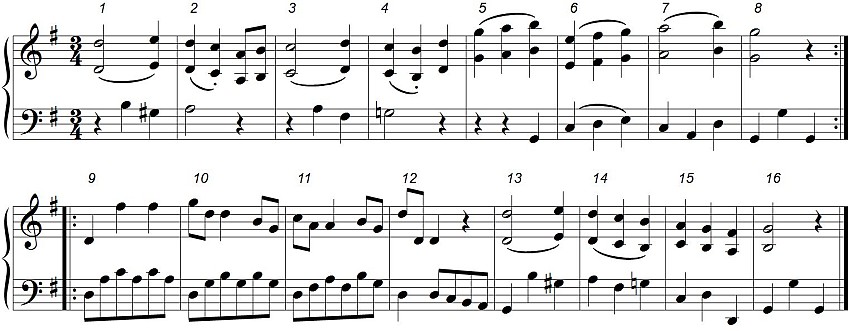
Figure 14: W.A.Mozart, Minuet K.315a,2.
I chose a minuet not only for practical reasons (short and simple) but also because many authors recommend the study of minuets. According to Riepel composing a minuet is no different from composing a concerto, aria or symphony.17Riepel, Anfangsgründe zur musicalischen Setzkunst - Tactordnung, i, 1.
We might not immediately consider bar 2 as having a cadence but melodically it conveys the right formula, helped by the left hand coming to rest, followed by a pause. It confirms with Riepel's rule for having a clear division at the beginning in either 4 or 2 + 2 bars. It is not a very strong cadence though; using the hierarchies we can increase the feeling of repose by, for instance, creating pauses in the melody (Fig. 15, I added the left hand notes to prevent an empty moment.)
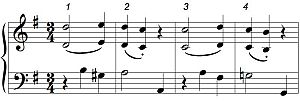
Figure 15: Increasing repose by adding pauses.
Conversely the cadence could be weakened by, for instance, creating more rhythmic ‘unrest’ (displacing the expected bass note in bar 2 to the second beat, and delaying the appoggiatura in the melody to an unimportant moment between beats), and by adding harmonic instability (see Fig. 16). Incidentally, the cadence in bar 4 is relatively stronger now by leaping into the final bass note.

Figure 16: Decreasing repose by adding rhythmic 'unrest' and harmonic instability.
The cadence in bar 4 is stronger than in bar 2 anyway by virtue of being on the tonic, the slight harmonic instability created by the G# in bar 1 comes to rest here in the keynote, and the expectation of a cadence here (created by the symmetry of bar 1-2 and 3-4) increase the feeling of repose.
A cadence at bar 6 is carefully avoided: there is harmonically a IV, no rhythmic variation, and melodically no specific formula—the imitation between top and bass undermines the possibility of coming to rest in the same spot even further. In bar 8 follows the strongest cadence till now with an unbeweglich octave-cadence and a bass ‘falls’ on the tonic with a leap.
However, the cadence of bar 8 cannot be the strongest in the piece, that should rightfully be reserved for the end of the piece. Compared to bar 16, the cadence in bar 8 is weakened by the avoidance of a proper V-I; an F# in the melody (bar 7) would probably have caused too definite an ending.
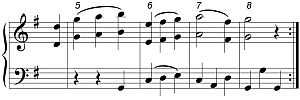
Figure 17: Making the cadence too strong.
Also context makes this bar 16 more powerful: by the absence of a strong cadence in the previous 8 bars (this could be the reason why the rhythm remains so active in bar 12), and not to forget the expected release after 8 + 8 bars (symmetry).
Taking the relatively simple cadence theory seriously, illustrates the beauty and ingenious structure of a simple piece like this.
In tweaking cadences we are actually playing with musical punctuation. For Mozart’s minuet we could chart the punctuation as follows:

Illustration 18: Possible punctuation of Mozart's minuet.
More interesting than the exact names and hierarchy is the fact that it is not a rigid system and leaves room for interpretation. Georg Simon Löhlein (1725-1781) gives an example of a punctuated minuet where he, as the composer(!), leaves you a choice to treat bar 1-4 as either a short period or a phrase (Fig. 19 at (a)).18Georg Simon Löhlein, Clavier-Schule oder kurze und gründliche Anweisung zur Melodie und Harmonie, 2nd edition, 1773, 181.

Figure 19: Löhlein's punctuated minuet.
The ambiguity is of course caused by the relatively strong cadence; had it been a weaker cadence on the dominant there would be no doubt it was a phrase instead of a short period:

Figure 20: Cadence in bar 4 weakened by going to the dominant.
Likewise in Mozart’s minuet I perceive bar 14 as a weak cadence, but strong enough to create a comma, helped by the thematic similarity to bar 1-2. In performance I would support the comma coming across by making the most of the absence of a slur in bar 15, maybe exaggerating a staccato touch to set it apart from the previous bar. You could as well argue the cadence is so weak (or even non-existent) that the last 4 bars have to be taken together, the absence of a slur just being short-hand notation for an implied slur similar to bar 14–or one could even reason the slur in bar 14 to be mainly structural, indicating the third beat is not an upbeat like in bar 2.
This freedom does not imply that punctuation is any less essential or even arbitrary. Daniel Gottlob Türk (1750-1813) gives an example in his piano tutor to prove the point: Er verlor das Leben, nicht nur sein Vermögen as opposed to Er verlor das Leben nicht, nur sein Vermögen (‘He lost his life, not only his wealth’ as opposed to ‘He lost his life not, only his wealth’.). In this case the comma is literally a matter of life and death. Less life-threatening but ‘equally unclear, or rather false, will the performance of a musical thought become by incorrect punctuation.’19Daniel Gottlob Türk, Klavierschule, oder Anweisung zum Klavierspielen für Lehrer und Lernende (Leipzig und Halle, 1789), 340.
Löhlein brings up another interesting point. The phrase-member at Fig. 19 *** gets a special mention requiring continuation like a double dot (duo puncta), so basically it is a comma which functions like a colon. Therefore a comma can separate (like Fig. 19 *) or connect. It is tempting to think of punctuation as only creating separations but it also serves the other side of the coin: linking. As defined by McArthur, punctuation is ‘the practice in writing and print of using a set of marks to regulate texts and clarify their meanings, principally by separating or linking words, phrases, and clauses, and by indicating parentheses and asides’ (my italics).20McArthur, Tom, Concise Oxford Companion to the English Language (Oxford, 1998), s.v. punctuation.
Three examples from his book:
- Period
- ‘There was no truth in the accusation. The other problem was why they had not been warned.’ (greatest separation, creating strong and distinctive statements.)
- Colon
- ‘There was no truth in the accusation: they rejected it utterly.’ (more connected, one thought leads to a conclusion.)
- Semicolon
- ‘There was no truth in the accusation; it was totally false.’ (continuity of thought by linking the two related statements.)
But punctuation not only clarifies structure (like phrases in music), it is also an agent in the delivery of these phrases (like phrasing in music), marking especially the pauses where breath should be taken. In one of the first textbooks on the English language, the Orthoepia Anglicana (1640), Simon Dains specifies ‘a small pause for the necessity of breathing’ for a comma, a double pause ‘yet very small’ for a semicolon, and double again for a colon. A period after which a new sentence starts gets double the pause of a colon, but a period that ends an ‘integrall part’ gets even four times the pause of a colon. He teaches his pupils to count in their reading, just as he was once taught to count by his ‘singing-Master’.21Simon Daines, Margarete Rösler and Rudolf Brotanek, Simon Daines’ Orthoepia anglicana (1640), Neudrucke Frühneuenglisher Grammatiken (Halle a.S., 1908), iii, 70.
Additionally punctuation can also be responsible for the more subdued delivery of a subordinate clause as opposed to a principal clause, the raising of the voice towards an exclamation mark, etc.